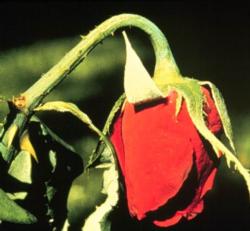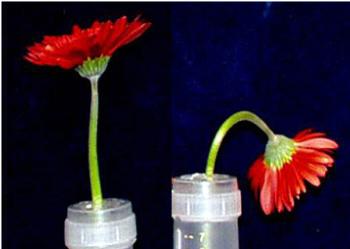by Richard Evans
This is a story about orangeburg. With luck, it’s the only one you’ll ever encounter. The eponymous product of a manufacturing town in New York, orangeburg is a pipe material made from wood that has been ground up, compressed and impregnated with coal tar pitch. It's basically a cellulose pipe. It collapses easily because it doesn't hold up to pressure. During the housing boom after World War II, when cast iron was hard to come by, it was used for sewer lines in some towns. Towns like Davis, where I live. You might think such a material would be a poor choice for a buried pipe. I do. I've learned a lot about it (www.sewerhistory.org) because the orangeburg sewer line under my house just collapsed. More precisely, it collapsed under the concrete slab that some moron poured for an addition to my house about 30 years ago. By then the orangeburg already had surpassed its expected lifespan, so I guess I’m lucky it survived this long.

Problems with clogged and collapsing lignified cellulose pipes (xylem) shortens the vase life of cut roses. Photo courtesy of Michael Reid.
Intractable problems with clogged and collapsing lignified cellulose pipes got me thinking about their role in shortening the vase life of cut flowers. Despite the absence of an orangeburg prompt, Li and others (2012) at Zhongkai University in China had something similar on their minds. To find out how bacteria affect vase life of cut roses, they isolated the dominant strains from the base of cut stems of ‘Movie Star’ roses, added known amounts of those bacteria to vase water and examined the effect on vase life. They also tested the efficacy of an antibacterial agent, nanosilver. Nanosilver materials, which contain nanoscale silver particles (5 to 50 nanometers in diameter, so you could line up about a million of them per inch, if you were patient enough), have been shown to inhibit bacterial growth. The rose researchers isolated four dominant bacterial strains and found that all are capable of plugging xylem, the water-conducting tubes in plant stems. An initial bacterial concentration of 100 million colony-forming units per milliliter of vase water caused cut roses to lose fresh weight because water loss from transpiration exceeded the capacity of the partially plugged stems to conduct water. Cut stems that were pretreated for 1 hour with 50 ppm nanosilver had almost no bacteria in the xylem or on the cut surface. This adds further support to earlier work by the group (Lü and others 2010), which showed that a nanosilver pretreatment can double the vase life of roses.
Industry veterans among you may recall that some cut flowers may be pretreated with silver thiosulfate to protect them from effects of ethylene. However, product registration issues, along with strict regulation of waste disposal because of concerns about environmental effects of silver, have limited the commercial availability of STS products. So what about the effects of nanosilver? Nanosilver materials are relatively new, so there isn’t much of a record on which to judge. Luoma (2008) and Marambio-Jones and Hoek (2011) have written reviews urging caution when introducing nanosilver into waste streams, but more testing is likely before regulatory guidelines are established. Stand by.

Stem failure in gerbera seems to be the result of both mechanical weakness and excessive water loss in the sensitive region of the stem. Photo M. Reid
Perik and others (2012) in the Netherlands investigated the role of xylem in flower vase life from another angle. They asked whether stem bending in cut gerberas (a.k.a. “conking”) is due to adverse water balance (i.e., more water lost to transpiration than gained by uptake through the stem), or to mechanical weakness of the stem. They found that water loss during vase life didn’t occur in the flower head, but did occur 4 to 6 inches below the flower head, in the region where stem bending usually occurs. When the researchers prevented water loss through that part of the stem, the time to stem bending doubled from 7 to 14 days. They also wondered whether bending occurs in some gerbera varieties because the growing stem tissue is weak and collapses under adverse vase life conditions. They examined the amount of cell wall thickening in gerbera stems and found that stems prone to bending have less thickening compared with unbent stems. Thus, stem failure in gerbera seems to be the result of both mechanical weakness and excessive water loss in the sensitive region of the stem. The authors offered no recommendation for solving these problems, but I think replacing the orangeburg might be a start.
Richard Evans is Cooperative Extension Environmental Horticulturist, Department of Plant Sciences, UC Davis.
References
Li H, Huang X, Li J, Liu J, Joyce D, He S. 2012. Efficacy of nano-silver in alleviating bacteria-related blockage in cut rose cv. Movie Star stems. Postharvest Biology and Technology 74: 36-41.
Lü P, Cao J, He S, Liu J, Li H, Cheng G, Ding Y, Joyce DC. 2010. Nano-silver pulse treatments improve water relations of cut rose cv. Movie Star flowers. Postharvest Biology and Technology 57: 196-202.
Luoma SN. 2008. Silver nanotechnologies and the environment: old problems or new challenges? Woodrow Wilson International Center for Scholars, Project on Emerging Technologies 15. Washington, DC. 72 pp.
Marambio-Jones C, Hoek EMV. 2010. A review of the antibacterial effects of silver nanomaterials and potential implications for human health and the environment. Journal of Nanoparticle Research 12: 1531-1551.
Perik RRJ, Razé D, Harkema H, Zhong Y, van Doorn WG. 2012. Bending in cut Gerbera jamesonii flowers relates to adverse water relations and lack of stem sclerenchyma development, not to expansion of the stem central cavity or stem elongation. Postharvest Biology and Technology 74: 11-18.














